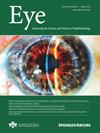Clinical features, risk factors and outcomes of contact lens-related bacterial keratitis in Nottingham, UK: a 7-year study
IF 2.8
3区 医学
Q1 OPHTHALMOLOGY
引用次数: 0
Abstract
To examine the clinical characteristics, risk factors and outcomes of contact lens-related bacterial keratitis (CLBK) in a large UK tertiary referral centre. A retrospective analysis of all patients who presented to the Queen’s Medical Centre, Nottingham, UK, with suspected CLBK between October 2015 to September 2022 (a 7-year period) was performed. Relevant data on demographic factors, CL wear behaviour, causes, clinical characteristics, and outcomes were analysed. We included 138 patients with CLBK; the mean age was 42.0 ± 17.8 years and 74 (53.6%) patients were male. Most CLBK were related to soft CL wear (94.5%), particularly monthly disposable (42.5%) and daily disposable (24.4%) CLs. Poor CL wear behaviour/hygiene was documented in 57.1% cases. Among the 64 (46.4%) microbiological-positive cases (n = 73 organisms), Pseudomonas aeruginosa (36, 49.3%) and Staphylococcus spp. (16, 21.9%) were most commonly identified. Six (4.3%) cases were polymicrobial. Most (97.0%) patients were successfully treated with topical antibiotics alone, with 80.6% achieving good final corrected-distance-visual-acuity (CDVA) of ≥ 0.30 logMAR. Poor visual outcome (final CDVA < 0.30 logMAR) was significantly associated with presenting CDVA < 0.6 logMAR (p = 0.002) and central ulcer (p = 0.004). Poor corneal healing (complete healing of > 30 days from initial presentation) was significantly associated with age > 50 years (p = 0.028), female gender (p = 0.020), and infiltrate size >3 mm (p = 0.031). Poor CL wear behaviour/hygiene is commonly observed in CLBK, highlighting the importance of improved counselling and awareness regarding CL use and hygiene. When presented early and managed appropriately, most patients are able to achieve good clinical outcomes with medical treatment alone.


英国诺丁汉与接触镜相关的细菌性角膜炎的临床特征、风险因素和结果:一项为期 7 年的研究
背景/目的研究英国一家大型三级转诊中心中与隐形眼镜相关的细菌性角膜炎(CLBK)的临床特征、风险因素和预后。研究对象/方法回顾性分析了2015年10月至2022年9月(7年时间)期间前往英国诺丁汉女王医疗中心就诊的所有疑似CLBK患者。结果我们纳入了138名CLBK患者;平均年龄为(42.0 ± 17.8)岁,74名(53.6%)患者为男性。大多数 CLBK 与软性 CL 佩戴有关(94.5%),尤其是月抛型(42.5%)和日抛型(24.4%)CL。57.1%的病例记录了不良的 CL 佩戴行为/卫生习惯。在 64 个(46.4%)微生物阳性病例(n = 73 个微生物)中,最常见的是铜绿假单胞菌(36 个,49.3%)和葡萄球菌(16 个,21.9%)。6例(4.3%)为多微生物病例。大多数患者(97.0%)仅通过局部抗生素治疗就获得了成功,其中 80.6% 的患者最终矫正视力(CDVA)≥ 0.30 logMAR。视觉效果差(最终 CDVA < 0.30 logMAR)与出现 CDVA < 0.6 logMAR(p = 0.002)和中央溃疡(p = 0.004)显著相关。角膜愈合不良(自初次发病起 30 天内完全愈合)与年龄 50 岁(p = 0.028)、女性(p = 0.020)和浸润大小 3 mm(p = 0.031)显著相关。如果早期就诊并得到适当的治疗,大多数患者仅通过药物治疗就能获得良好的临床效果。
本文章由计算机程序翻译,如有差异,请以英文原文为准。
求助全文
约1分钟内获得全文
求助全文
来源期刊

Eye
医学-眼科学
CiteScore
6.40
自引率
5.10%
发文量
481
审稿时长
3-6 weeks
期刊介绍:
Eye seeks to provide the international practising ophthalmologist with high quality articles, of academic rigour, on the latest global clinical and laboratory based research. Its core aim is to advance the science and practice of ophthalmology with the latest clinical- and scientific-based research. Whilst principally aimed at the practising clinician, the journal contains material of interest to a wider readership including optometrists, orthoptists, other health care professionals and research workers in all aspects of the field of visual science worldwide. Eye is the official journal of The Royal College of Ophthalmologists.
Eye encourages the submission of original articles covering all aspects of ophthalmology including: external eye disease; oculo-plastic surgery; orbital and lacrimal disease; ocular surface and corneal disorders; paediatric ophthalmology and strabismus; glaucoma; medical and surgical retina; neuro-ophthalmology; cataract and refractive surgery; ocular oncology; ophthalmic pathology; ophthalmic genetics.
 求助内容:
求助内容: 应助结果提醒方式:
应助结果提醒方式:


